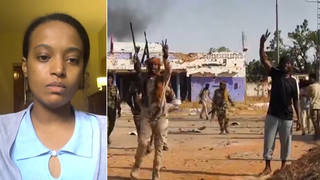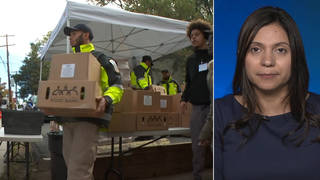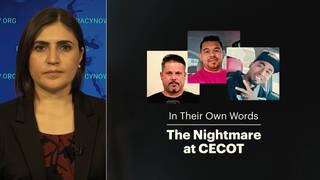
Topics
We take a look at the case of a torture-victim from El Salvador who confronted two former Salvadoran generals living in the U.S. He won a watershed victory last summer when a jury ruled that the two generals held “command responsibility” over abuses by the military. We speak with an investigative journalist who covered the story. [Includes transcript]
Click here to read to full transcript Could your neighbors be war criminals?
Well over the years hundreds of human rights violators from around the world have found their way into the United States. Many of them settling in the same communities as their former victims.
According to a recent report by Amnesty International, as many as 1,000 human-rights violators from around the world live in the U.S.
But unlike former Nazis—who for decades have been subject to a concerted federal effort to find and deport them—most retired torturers have little to fear from the U.S. government. Until now.
In December 1980, investigators pulled four bodies from a shallow grave along a remote road in El Salvador. They were the bodies of three American nuns and a lay worker who had come to El Salvador to minister to the poor.
The women had been abducted, raped, and killed by members of El Salvador’s national guard. The murders made headlines around the world.
Thirteen years later, a truth commission established by El Salvador’s new civilian government issued a report naming dozens of top officials responsible for atrocities during the late 1970s and early ’80s. High on its list were two generals, Jose Guillermo Garcia and Carlos Eugenio Vides Casanova.
The truth commission hadn’t been able to interview Garcia and Vides Casanova–they had settled in Florida in 1989, having come to the United States on legal, U.S. Embassy-issued visas.
In 1999, relatives of the churchwomen filed a lawsuit against Garcia and Vides Casanova, but the men successfully argued that they could not be held responsible for the actions of rogue subordinates.
By last summer, however, the generals’ luck had run out. They were in court again, facing claims from three victims of military abuses, including a doctor, Juan Romagoza, who had been tortured in the Salvadoran national guard’s headquarters. A jury concluded that Garcia and Vides Casanova held “command responsibility” over the crimes. They were ordered to pay their victims $54.6 million.
- Joshua Philips, investigative journalist and author of a recent piece in the Washington Post Magazine detailing the case of Juan Romagoza, an El Salvadoran refugee who won a case last year against two Generals guilty of war crimes in El Salvador’s dirty war.
TRANSCRIPT
Amy Goodman: Could your neighbors be war criminals? Well over the years hundreds of human rights violators from around the world have found their way into the United States; many of them have settled in the same communities as their former victims.
In December 1980 investigators pulled four bodies from a shallow grave along a remote road in El Salvador. They were the bodies of three American nuns and a lay worker who had come to El Salvador to minister to the poor. The women had been abducted raped and killed by members of El Salvador’s National Guard. The murders made headlines around the world. Thirteen years later a truth commission established by El Salvador’s new civilian government issued a report naming dozens of top officials responsible for the atrocities during the 70’s and early 80’s.
High on its list were two generals: Jose Guillermo Garcia, and Carlos Vides-Casanova, formerly El Salvador’s Defense Minister and National Guard Chief. But the truth commission hadn’t been able to interview Garcia and Vides-Casanova because they settled in Florida in 1989, having come to the U.S. on legal U.S. embassy-issued visas. In 1999 relatives of the church women filed a lawsuit against Garcia and Vides-Casanova but the men successfully argued they could not be held responsible for the actions of rogue subordinates. By last summer, however, the Generals’ luck had run out, they were in court again facing claims from three victims of military abuses including a Dr. Juan Ramagoza who had been tortured in the El Salvadorian National Guard’s headquarters. A jury concluded Garcia and Vides-Casanova held command responsibility over the crimes. They were ordered to pay their victim 54.6 million dollars.
We’re joined right now by Joshua Phillips who’s an investigative journalist, author of a recent piece, front page of the Washington Post Magazine. Welcome to Democracy Now.
Joshua Phillips: Thank you.
Goodman: Can you further tell us his story?
Phillips: Sure, Dr. Juan Ramagoza was a Salvadoran doctor, a surgeon who helped serve the communities of the El Salvadoran poor, and he went to the “red zones” — the areas that were most affected by the El Salvadoran civil war — to administer aid and in the course of doing that he was abducted. He was shot along with the other doctors and nurses and then abducted by the National Guard and later tortured for several weeks. He then fled El Salvador, came to the U.S. In the U.S. he helped form and work for various organizations that serve Central American communities and eventually worked as a director of a Washington, D.C. health clinic, and while working as the head of this clinic he discovered that the two generals you mentioned, Generals Garcia and Vides-Casanova were living lives as Florida retirees and so he, along with two other torture victims sued them in a US civil court.
Goodman: Now, his case was originally part of that with Ita Ford and the four church women’s case of the 1980’s…
Phillips: Right, well they were going to conjoin the case originally but they later decided to separate them.
Juan Gonzalez: And for most listeners they may not be aware to what extent there are so many of these war criminals here in the United States. How prevalent is this?
Phillips: They’re very prevalent but we don’t have very precise numbers. The person who is generally tracking these people, and who hunts down and identifies the various human rights violators and torturers and war criminals is Richard Krieger. There is a U.S. Government department that also does this work as well. Government officials said that there are about 800 to a thousand of these human rights violators and Richard Krieger said that there’s about 1100
Goodman: “A Tortured Path to Justice” is the name of your piece. The two generals from El Salvador were given US embassy-issued visas they didn’t sneak into the country.
Phillips: That’s right. In fact Jose Guillermo Garcia who was, arguably, among the worst perpetrators of human rights violations…the man who was in power, the man whose minister of defense during the Sumpul River massacre and the massacre of El Mozote which claimed nearly a thousand lives…he was given political asylum not just “a visa”. So this is while 97% of Salvadorans entering the U.S. were rejected political asylum many of them were deported many of them were sent back and even killed in El Salvador.
Goodman: The US complicity with what took place in El Salvador has now been well documented. Right to the training of the soldiers, the knowledge of what they did. So we’re not just talking about human rights abusers who are from other countries, but right here in the United States, those that facilitated the kind of torture that you were describing.
Phillips: Yeah, without a doubt. Well there are human rights violators from all over the world that are living here. Many of them — in fact human rights investigators have said that most of them actually come from Latin America — and many of those that come from Latin America, of course, came over here within a time frame which would have established them with some sort of connections to the US’ help or assistance during the Cold War.
Goodman: I want to thank you very much Joshua Phillips for being with us. His piece is a front page Magazine Piece the Washington Post “A Tortured Path to Justice” — the August 17th edition. Thank you for being here.











Media Options